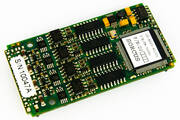X-AD20-4i
X-AD20-4i
Description
Four sensor elements such as strain gauges (4 and 6 wire), temperature measurement resistors (e.g. Pt100), or thermocouples (of all types) can be connected directly to the X-AD24-4i in order to measure temperature, vibration, pressure or electrical resistan-ce. Each sensor channel delivers 24 bits resolution, and is electrically isolated from the rest of the module. Conversion is carried out with the aid of integrated interfe-rence suppression of the 50 or 60 Hz frequency. In the /S, /P and /T versions this cor-responds to a measurement rate of 6.25 or 7.25 samples per-second, respectively. Alternatively, conversion can also be carried out at 97.5 samples per second (versions /S, /P and /T) or at 42 kSPS (versions /V, /C, /F and /I).
The supply voltage required for strain gauges is delivered for each sensor directly from the module, and is electrically isolated. Different types of thermocouple are used for measuring particularly high or particularly low temperatures. These can be connected directly to the module, regardless of their type. Linearisation and cold junction compensation are performed by the driver software. 4-wire connection is used for accurate temperature measurements with the aid of Pt100 or Pt1000 tempe-rature measuring resistors, in order to compensate for parasitic resistances in the supply lines.
Input ranges
The modules offer 4 A/D converters, each having a differential measurement input and a differential reference input. Each A/D converter is electrically isolated from the other converters and from the X-Bus. The supply voltage provided by the con-verter limits the input range to 0-5 V, although the use of an operational amplifier can permit an input range from –10 V up to +10 V (/V version). The modules are suitable for connecting sensor elements such as strain gauges (4 and 6 wire), tempe-rature measuring resistances (e.g. Pt100) or thermocouples (of all types), and pro-vide an electrically isolated 5 V power supply for the sensors. The external voltage supply for ICP sensors is 24V@4mA. For sensors with a current interface, module version C is available with a 0..20mA input current range.
Other ranges are possible if the operational amplifier's input circuitry is modified.
Converters used, anti-aliasing and oversampling
The modules use A/D converters operating according to the sigma-delta algorithm. These converters sample the analog signal at a high internal frequency, and perform the conversion with the aid of a digital SINC filter. The analog bandwidth of the input is significantly less than that of the results rate, which means that anti-aliasing filters are usually unnecessary. Additional low-pass filters are necessary for applications where the bandwidth of the input signal can be greater than 256-fold the results rate. Thanks to the large margin of separation from the useful signal, however, this can be implemented with simple RC filters.
Specifications
| Parameter | Randbedingungen | Wert | Einheit |
| Analoge Eingänge: | |||
| Anzahl | Alle Modultypen ausser /T | 4 differenz | |
| Anzahl | Modultyp /T | 8 single-ended | |
| Messgenauigkeit | 7,5SPS | min.: 17; typ.:19; max.: 24 | Bit |
| Messgenauigkeit | 97,5SPS | min.: 16; typ.:18; max.: 24 | Bit |
| Messgenauigkeit | 42,5kSPS | min.: 14; typ.:15; max.: 21 | Bit |
| Analogbandbreite Modultyp /S, /P und /T | bei 50Hz Unterdrückung | min.: 0; max.: 3,02 | Hz |
| Analogbandbreite Modultyp /S, /P und /T | bei 60Hz Unterdrückung | min.: 0; max.: 3,63 | Hz |
| Analogbandbreite Modultyp /S, /P und /T | bei 97,5 SPS | min.: 0; max.: 47,1 | Hz |
| Analogbandbreite (-3dB) Modultyp /C und /V | bei 50Hz Unterdrückung | min.: 0; max.: 10,8 | Hz |
| Analogbandbreite (-3dB) Modultyp /C und /V | bei 60Hz Unterdrückung | min.: 0; max.: 12,9 | Hz |
| Analogbandbreite (-3dB) Modultyp /C und /V | bei 42,5 kSPS | min.: 0; max.: 9100 | Hz |
| Analogbandbreite (-3dB) Modultyp /I | bei 42,5 kSPS | min.: 1,5; max.: 9100 | Hz |
| Integrale Nichtlinearität | Tmin ... Tmax | max.: +/-4 | LSB |
| Differentielle Nichtlineariät | Tmin ... Tmax | max.: +/-1,5 | LSB |
| Verstärkungsfehler | Tmin...Tmax, per Software korrigierbar | max.: +/-2 | mV |
| Verstärkungs-Temperatur-Koeffizient Modultyp /S, /P und /T | Tmin...Tmax, per Software korrigierbar | typ: 2 | ppm/°C |
| Verstärkungs-Temperatur-Koeffizient Modultyp /V, /C und /I | Tmin...Tmax, per Software korrigierbar | typ: 7,5 | ppm/°C |
| Offset-Fehler | Tmin...Tmax, per Software korrigierbar | max.: +/-4 | mV |
| Ergebnisrate pro Kanal Modultyp /S, /P und /T | bei 50Hz Unterdrückung | max.: 7,5 | Hz |
| Ergebnisrate pro Kanal Modultyp /S, /P und /T | bei 50Hz Unterdrückung | max.: 7,5 | Hz |
| Ergebnisrate pro Kanal Modultyp /S, /P und /T | bei 60Hz Unterdrückung | max.: 6,25 | Hz |
| Ergebnisrate pro Kanal Modultyp /S, /P und /T | Maximal | max.: 97,5 | Hz |
| Ergebnisrate pro Kanal Modultyp /V, /C und /I | bei 50Hz Unterdrückung | max.: 50 | Hz |
| Ergebnisrate pro Kanal Modultyp /S, /P und /T | bei 60Hz Unterdrückung | max.: 60 | Hz |
| Ergebnisrate pro Kanal Modultyp /S, /P und /T | Maximal | max.: 42,5 | kHz |
| Versorgungsspannungen des Moduls: | |||
| Versorgungsstrom | für +3,3 V | typ.: 165 | mA |
| Versorgungsstrom | für +3,3 V | typ.: 165 | mA |
| Versorgungsstrom | für +/-12 V (nicht /I) | typ.: 0 | mA |
| Versorgungsstrom | für +/-12V (/I-Version) | typ.: 16 | mA |
| Temperatur-Bereich: | |||
| Betrieb | -40 ... +85 | °C | |
| Lagerung | –40 ... +85 | °C |



